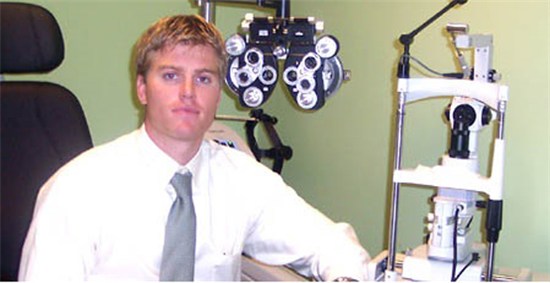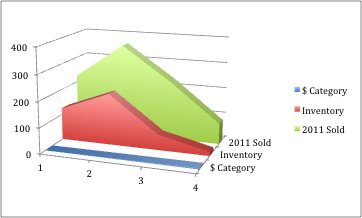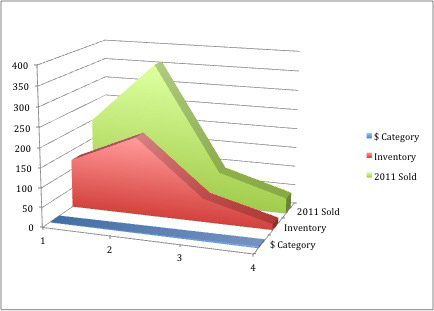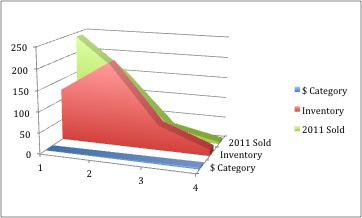By Charles Turner, OD
Implement an organized, consistent system to manage frame inventory. Here are three simple steps for you or your optical manager to follow.
When considering making new purchases in frame inventory, ODs often instruct their opticians to buy, with no direction, and they wonder if the frames that were purchased will make a difference. Many questions come to the minds of ODs with few answers. Do I need more inventory? What should I buy? Will my patients pay for a pricey frame? Do I have too many frames that retail at a certain price point? Does this thinking sound familiar? Many of you right now are thinking, “I wonder if we should add inventory, and what prices are right for my office?”
By following three simple steps you can answer all of the above questions, and have the confidence to make your next purchase. Here’s how:
Step 1: Take an inventory of your optical, and note how many of your frames fall into specific retail pricing categories. For example: Frames that retail for $100-$199 we will call category one, frames that retail for $200-$299 we will call category two, and so on.
Step 2: Perform the same category analysis in Step 1, but perform this with what you sold in 2011.
Step 3: Graph the results side by side, and analyze.
Once you have your results, you can compare them with the following three likely outcomes of this analysis.
The “Right-Skew”

Outcome 1: As you can see above, you are selling better than you are showing with your inventory, and your inventory vs. sold graph is skewed to the right. By patients purchasing higher-volume percentages of category three and four, your graph is skewed right, and it is skewed just right. This is the best-case scenario. Your patients are buying frames at higher volumes of prices that you have in inventory. You can confidently buy more frames in higher price categories to reflect what you are selling.
Action: Ask your optician to look for new frames in higher price categories. The next inventory purchase in your office now has direction. By purchasing in a higher category, this trends your inventory to the right, so you can meet your patients’ habits.
The “Mirror-Image”

Outcome 2: As you can see above, you are selling almost exactly what you are showing your patients, and your inventory vs sold graph is a mirror image.
This is close to a best-case scenario as well. This outcome is very common. Your patient base trusts your office with the products that you have, and the price points that you have, so you can feel confident to skew your next purchasing to the right on the graph, i.e. higher price points. If trends continue, your base will support your decision with their new spending habits and options.
Action: If, after six months of your next purchase your patients did not follow your new pricing model, your previous model was the exact right mix for your current office, current service and current patient demographic.
The “Steep Decline”

Outcome 3: You are selling less than what you are showing, and your inventory vs. sold graph is skewed left. This has the potential to be a multi-factor issue. The potential reasons for selling less than you have in inventory are: Low patient flow, poor customer service, poor frame styles and inventory, excessive purchasing by staff and reps, high rates of Rx walk-out, poor doctor effort in educating patients on new ophthalmic options, outdated dispensary, or over-shooting your office demographic.
Action: If you find your office in outcome three, do not automatically assume that you have purchased too high for your area. Most ODs make that assumption, but in actuality, it’s the least likely scenario. Most often it’s a combination of a non-recommending OD in the exam room, coupled with poor customer service.
What can I do if my office is in outcome three? It’s time for a culture change; first, in your mind as the OD, and second with the staff. It’s time to start thinking of yourself as a vision consultant, and not just an OD. Educate your next 10 patients on the latest non-glare technology, high definition lenses and your industry leading warranties. Hold weekly staff meetings to discuss your renewed sense of why your patients should be buying from you. Write down the top five reasons your patients should purchase from your office, and introduce those reasons in your next meeting. This top five card makes a great handout for patients.
Start wearing eyeglasses to work! Make eyeglasses a mandatory uniform requirement. Become a patient advocate for better visual quality of life. Prescribe situational specs, workstation eyeglasses, sunglasses, sports eyeglasses and adopt lifestyle dispensing habits. Don’t try and tackle all of those tips at once, but start with the easiest one for you, and start today.
When to buy?
If you are selling at least 2x your inventory, feel comfortable about adding to your inventory. Set a goal for your optical to add at least one new style per year, which may replace an existing poor performer, or will add to your inventory. Remember; the graph never lies. Follow this simple tracking and graphing technique to analyze your inventory on six-month cycles, and you will never wonder if you are making a good decision with inventory purchases again.
Related ROB Articles and Multimedia
Frame Board Profitability Requires Hands-On Management
10 Action Points to Improve Your Optical Dispensary
Charles Turner, OD, practices at Island Eye Care in Daniel Island, SC. To contact him: islanddoc@gmail.com





















